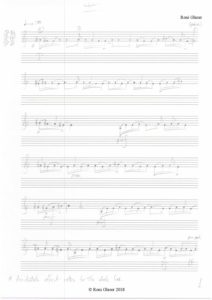Welcome back. This week you can hear me playing the six-part canon, the first one in the series of canons I told you about last week. You can see the score here too.
Reflections
Successes
While I did indeed write this as an exercise of what I thought would be the maximum number of voices the instrument could handle, a canon has no musical value if it is just a canon for the sake of a canon. And so I’m pleased to say there are some things I like about the piece musically:
- The sombre mood created by the melody and the harmony;
- The harmony – although I more or less just created it from whatever notes my fingers could reach and is a bit tricky to pinpoint tonally, it doesn’t feel unnatural to me;
- The arc of development of the piece – the way it grows and declines;
- I liked my idea of taking advantage of the guitar’s natural tuning by making it a canon at the fourth (i.e. the melody in each new voice is at an interval of a perfect fourth above the previous voice), and limiting the range to the first four frets of each string, enabling each voice to remain on each string, and the piece to be playable;
- I was actually able to play it;
- It also has the climax at exactly the golden section, that is, at 0.618… of the way through (approximately). It definitely counts as on purpose, seeing as I’ve made the conscious decision to leave it like that after noticing it…
Shortcomings
The tight technical restrictions did still make it difficult to bring as much musicality to it as I might like in a few areas:
- The melody of the canon didn’t have much in the way of characteristic motifs, other than the first bar or two, and after the third bar the notes were used almost purely for the harmony, and so that it would be a canon with six voices sounding at the same time. By the time the fifth voice entered, I was basically too limited by what my fingers could do (and by the fact it was a strict canon) to make the voices do any more than play an open string;
- Some of the chords have stretches that are almost impossible for me, and might be too difficult for other people.
- I might have liked the piece to be a bit longer, but this wasn’t possible because I didn’t manage to give the melody enough interest due to the restricted range of a fourth, and the lack of characteristic rhythms, thus there wasn’t much scope for development.
- I would’ve liked it to repeat, i.e. for it to go back to the beginning and feed into itself like canons often do. I tried various ways to get it to repeat, but it ended up being either impossible to play for the left hand, or I didn’t like the harmony. I’ll try again in future canons.
Lessons learnt
Although this is only a small piece, I still found a few useful things to help me in the future when composing or playing the guitar:
- As I mentioned, the range restriction was helpful to make it more playable. It is, however, hard to create characteristic melodies with such a small range of notes and little in the way of rhythm. I think if I’m crafty, I could use the restricted range at certain points in a piece and expand at others to balance musical interest and playability;
- If the left hand is too full, characteristic rhythms could be created by just repeating notes (I didn’t do this in this canon);
- There’s a lot to be said for not restricting the harmony too much and simply taking whatever notes are available. If you’re careful and understand the kind of chords, interval schemes etc. you’re using, it can be effective and coherent;
- On the guitar playing side of things, this canon has been a great exercise for me in legato playing with chords, i.e. linking the chords together so that the changes are smooth. Since it’s important for the melodic lines to be as legato as possible, you can choose to hold particular notes that stand out more while releasing the fingers on less important notes in preparation for the next chord. In this way, there is an illusion of legato because the sound doesn’t stop completely between chord changes and the melodies are maintained better. You can also spread chords (arpeggiate them) so that you have the fraction of a second necessary to move your fingers to the higher notes.
Next
I’ve been planning to compose this canon series counting down from six to two voices repeatedly, so the next canon would be for five voices. But on the other hand, I often like to compose pieces that are opposite in character to the one I’ve just written, so I might do two. We’ll have to wait and see. Watch this space!

